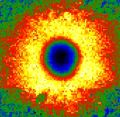Speaker
Description
The isolation of graphene in 2004 raised an enormous excitement in the community, bringing to light a fundamentally new class of low-dimensional materials. Soon after, the graphene's insulating cousin – hexagonal boron nitride – was introduced, initiating a burst of papers speculating about a new electronics era. Process scalability, which is necessary for the utilization of 2D materials on a larger scale, excludes the mechanical exfoliation and significantly narrows the choice of suitable growth techniques. In this regard, the most promising approach is that of chemical vapour deposition (CVD), in which the precursors are delivered from a gas phase to the substrate, where they react and form the growing layer. However, in contrast to exfoliated layers, those prepared by CVD exhibit a significantly higher concentration of various structural defects, which are detrimental to many quantum effects and device functionalities the physicists and engineers search for. The defect family in 2D materials includes domain boundaries (GBs) and twin defects, together with many types of vacancies and anti-sites. GBs were identified to play a critical role in many aspects. The mitigation strategies include specific sample preparation techniques or the use of single-crystal substrates.
Developing a more general strategy to avoid the formation of GBs within a footstep of the intended 2D-material-based device (and, preferably, at a wafer-scale) is desirable. Rheotaxy (growth on a liquid substrate) has been proposed as a viable method to achieve domain ordering and self-assembly already in 2012 for graphene [1]. However, it remains poorly explored due to a lack of in-situ experimental techniques that confirm or disprove hypotheses raised concerning the formation mechanisms [2]. Only recently, experimental studies started to pop-out [3].
We have utilised two modified microscopes for observing the graphene growth on liquid : a microReactor [4] in SEM and ultrahigh vacuum SEM. We observe graphene growth behaviour in situ, allowing to record movies of graphene flake behaviour on liquid gold and copper. We combine our electron microscopy observations with in situ AFM measurement of the contact angle of graphene on liquid gold, together with ex situ Raman characterization of the final graphene layer.
We have been able to demonstrate some aspects of the graphene growth on liquid substrate, that have been hypothesized so far, namely movement and ordering of the graphene flakes on liquid surface (Cu and Au), via real-time movies under various reaction conditions. The flakes seem to assemble into regular patterns on liquid surface, however, this pattern is prone to disturbances, caused by e.g. hydrodynamics of the liquid (Fig. 1). Additionally, we obtained kinetic data of graphene growth, allowing us to directly compare solid and liquid growth rates. These data show significant increase of reaction constants on liquid metal. Last, we will show in situ AFM data, discussing the possible presence of meniscus between the graphene flake and the liquid metal. Altogether, we frame these observations within a simple physical model.
In conclusion, we will show a quantitative analysis of in situ experimental data of graphene flakes assembly on liquid metal under growth reaction conditions. We combine in situ electron microscopy in different vacuum environments at extreme temperature with atomic force microscopy to show that the choice of the liquid metal is vital for achieving regular assembly of graphene and seamless stitching. We corroborate experimental observations with simple physical models of 2D solids floating on a liquid surface and explore weak-points of the synthesis, giving directions for further research towards scalable growth of 2D materials.
References:
[1] Geng, D. et al. PNAS 2012, 109, 7992-7996.
[2] Tsakonas, C.; Dimitropoulos, M.; Manikas, A. C.; Galiotis, C. Nanoscale 2021, 13, 3346-3373.
[3] Jankowski M. et al., ACS Nano 2021, 15, 9638-9648.
[4] Novák, L., Wandrol, P., Vesseur J. R. Micr.&Microanal. 2020, 26 (S2), 1144-1145.

